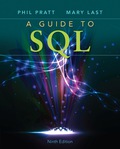
A Guide to SQL
9th Edition
ISBN: 9781337668880
Author: Pratt
Publisher: Cengage
expand_more
expand_more
format_list_bulleted
Concept explainers
Question
Chapter 1, Problem 10SCG
Program Plan Intro
SELECT statement:
It is used to retrieve information from the table or
Syntax:
SELECT * FROM table_Name;
Expert Solution & Answer
Want to see the full answer?
Check out a sample textbook solution
Students have asked these similar questions
4. |z + 5 - 5i| = 7
14.
dz,
C: |z❘
C: |z❘ = 0.6
ze² - 2iz
H
14.
dz,
C: |z❘
C: |z❘ = 0.6
ze² - 2iz
H
Chapter 1 Solutions
A Guide to SQL
Ch. 1 - Prob. 1TDCh. 1 - Prob. 2TDCh. 1 - Prob. 3TDCh. 1 - Prob. 4TDCh. 1 - Prob. 5TDCh. 1 - Prob. 6TDCh. 1 - Prob. 7TDCh. 1 - Prob. 8TDCh. 1 - Prob. 9TDCh. 1 - Prob. 10TD
Ch. 1 - Prob. 11TDCh. 1 - Prob. 1CATCh. 1 - Prob. 2CATCh. 1 - Prob. 3CATCh. 1 - Prob. 4CATCh. 1 - Prob. 5CATCh. 1 - Prob. 6CATCh. 1 - Prob. 7CATCh. 1 - Prob. 8CATCh. 1 - Prob. 9CATCh. 1 - Prob. 10CATCh. 1 - Prob. 11CATCh. 1 - Prob. 12CATCh. 1 - Prob. 13CATCh. 1 - Prob. 14CATCh. 1 - Prob. 1SCGCh. 1 - Prob. 2SCGCh. 1 - Prob. 3SCGCh. 1 - Prob. 4SCGCh. 1 - Prob. 5SCGCh. 1 - Prob. 6SCGCh. 1 - Prob. 7SCGCh. 1 - Prob. 8SCGCh. 1 - Prob. 9SCGCh. 1 - Prob. 10SCGCh. 1 - Prob. 11SCGCh. 1 - Prob. 12SCGCh. 1 - Prob. 13SCG
Knowledge Booster
Learn more about
Need a deep-dive on the concept behind this application? Look no further. Learn more about this topic, computer-science and related others by exploring similar questions and additional content below.Similar questions
arrow_back_ios
SEE MORE QUESTIONS
arrow_forward_ios
Recommended textbooks for you
 A Guide to SQLComputer ScienceISBN:9781111527273Author:Philip J. PrattPublisher:Course Technology Ptr
A Guide to SQLComputer ScienceISBN:9781111527273Author:Philip J. PrattPublisher:Course Technology Ptr

A Guide to SQL
Computer Science
ISBN:9781111527273
Author:Philip J. Pratt
Publisher:Course Technology Ptr
